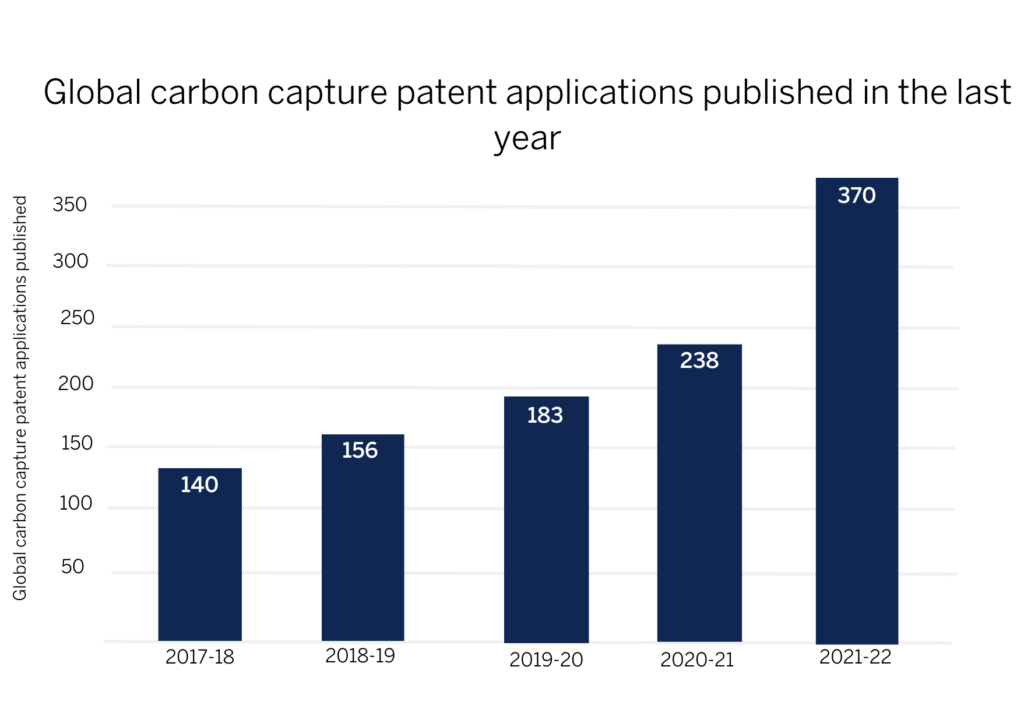Data and commentary provided by Mathys & Squire has featured in articles by The Patent Lawyer, City AM, Carbon Pulse and Carbon News providing an update on the rapid growth in carbon capture patents applications.
An extended version of the press release is available below.
There have been a record 411 global patent applications for carbon capture and storage technology published in the past year*, up 65% from 249 in 2020/21, shows new research by Mathys & Squire, the leading intellectual property law firm.
Carbon capture and storage technology is generally regarded as a crucial tool in meeting CO2 emission targets, and companies are investing heavily in research and development in this area. Crucially, companies are seeking to patent technological breakthroughs to protect their IP and monetise their technology effectively.
While companies across a number of sectors have filed carbon capture patent applications, a key player is of course the energy sector, from which there have been 41 such patent applications published in the past year. Energy companies have identified carbon capture technology as a major tool in their strategies to reduce emissions. Notable filers of carbon capture patents include Exxonmobil, Saudi Aramco and Unilever.
Specialist carbon capture businesses, which have been established in recent years, were nevertheless responsible for 19 of the patent applications published in the last 12 months.
The United Nation’s Intergovernmental Panel on Climate Change has stressed the importance of carbon capture in reaching global net zero**. This has been reflected in many governments increasing investment in the technology.
The US Government announced $2.6 billion in funding for carbon capture projects in July 2022***, while in the same month the EU announced €1.8 billion in funding for clean technology projects for reducing greenhouse gas emissions, including carbon capture****.
A further example of governments encouraging investment in carbon capture technology is the recent discussions between the US and Indonesian Governments, leading to a $2.5bn carbon capture agreement between ExxonMobil and Indonesian state-owned energy company, Pertamina.
73% of published global carbon capture patent applications originated from China
In 2021-22, 73% of the carbon capture patent applications published (298) were from Chinese applicants – largely from energy companies and universities. The USA came second place with 10% (42), whilst the UK accounted for only five patent applications published, corresponding to just 1.2% of the global total.
China recently opened its largest carbon capture facility in Shandong province, with plans to build two more similarly sized plants announced*****. China aims to be carbon neutral by 2060 and the accelerated investment in carbon capture plants suggests the technology is a core part of its plans.
Innovative examples of recent patent applications related to carbon capture include:
- Carbon capture technology designed to be used in coal-fired power stations
- A method of producing diamonds from carbon captured from the air
- A carbon capture system designed for use in domestic households
Debate remains over whether resources and investment should be focussed only on renewable technologies, or on the development of other solutions in parallel. Some see carbon capture technologies as extending reliance on fossil fuels and hampering a shift to renewable technologies in the long term.
Michael Stott, Partner at Mathys & Squire, says: “Companies have recognised the commercial opportunity in mastering carbon capture technology, which is likely to form a key part of meeting the global net zero objective, and supplementing the progress that continues to be made in the advancement of renewable technologies.”
“Companies are racing to develop their carbon capture technologies and secure their IP. Those that can patent the most effective technologies are likely to have a commercial edge as the global economy transitions to net zero.”
“However, the UK lags behind other parts of the world in developing carbon capture technology. The UK Government may wish to consider whether current funding structures provide enough support to research and development in this vital field.”
“Support for carbon capture technologies doesn’t have to take away from renewables research. When it comes to achieving the global net zero objective, encouraging innovation across a broad range of technology areas can only be to the benefit of posterity.”

*Year end June 30 2022
**IPCC Special Report
***US Department of Energy
****European Commission
*****Sinopec

